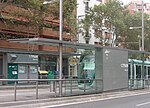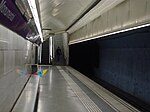Catalonia College of Music
Catalan building and structure stubsEurope university stubsMusic schools in SpainSpanish school stubs

The Catalonia College of Music (Catalan: Escola Superior de Música de Catalunya, ESMUC; IPA: [əsˈkɔlə supəɾiˈo ðə ˈmuzikə ðə kətəˈluɲə]) is a music school in Barcelona, Catalonia, Spain. The school is located at L'Auditori, a performing arts center inaugurated in 1999 which also houses three concert halls and a museum. The school has an international faculty and student body, and includes departments for classical and contemporary music, early music, jazz and popular music, traditional music, musicology and ethnomusicology, theory and composition, music education, music business, and sonology.
Excerpt from the Wikipedia article Catalonia College of Music (License: CC BY-SA 3.0, Authors, Images).Catalonia College of Music
Carrer de Lepant, Barcelona
Geographical coordinates (GPS) Address Nearby Places Show on map
Geographical coordinates (GPS)
| Latitude | Longitude |
|---|---|
| N 41.398055555556 ° | E 2.1858333333333 ° |
Address
L'Auditori (Auditori Nacional de Catalunya)
Carrer de Lepant 150
08013 Barcelona
Catalonia, Spain
Open on Google Maps











